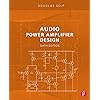

Ready to go? Add this product to your cart and select a plan during checkout. Payment plans are offered through our trusted finance partners Klarna, PayTomorrow, Affirm, Afterpay, Apple Pay, and PayPal. No-credit-needed leasing options through Acima may also be available at checkout.
Learn more about financing & leasing here.
Eligible for Return, Refund or Replacement within 30 days of receipt
To qualify for a full refund, items must be returned in their original, unused condition. If an item is returned in a used, damaged, or materially different state, you may be granted a partial refund.
To initiate a return, please visit our Returns Center.
View our full returns policy here.
Description
This is the essential book reference for amplifier designers. Douglas Self covers all the design issues of noise, distortion, power supply rejection, protection, reliability, and layout. He describes advanced forms of compensation that give dramatically lower distortion. This edition is much expanded, and packed with new information. It is a must-have for audio power amplifier professionals and audiophiles, amateur constructors and anyone with intellectual curiosity about the struggle towards technical excellence. New to the sixth edition:The characteristics of the audio signalThe principles of distortionFeedback intermodulation distortionNon-switching output stagesVAS distortion explainedPush-pull VAS configurationsOutput-inclusive compensationIn addition, five amplifier design examples that illustrate important design principles are examined and measured in detail. These can be straightforwardly adapted to specific requirements.This new edition also includes a wealth of material on the XD crossover-displacement principle (invented by the author and in use by Cambridge Audio), four-stage amplifier architectures, error correction, current-mirrors, power transistors with internal sensing diodes, amplifier bridging, input-stage-common-mode distortion, amplifier stability, output stages with gain, inrush current suppression, DC servo design, thermal protection, cooling fan control, advanced line input stages, testing and safety, infrared remote control, signal activation, 12V trigger control, the history of solid-state amplifiers and much more. Simple procedures for heatsinking and power supply design are given. Read more
Publisher : Routledge; 6th edition (July 18, 2013)
Language : English
Paperback : 718 pages
ISBN-10 : 0240526139
ISBN-13 : 33
Item Weight : 2.9 pounds
Dimensions : 9.2 x 7.5 x 1.5 inches
Best Sellers Rank: #522,191 in Books (See Top 100 in Books) #65 in Circuit Design #88 in Acoustic Engineering #177 in Physics of Acoustics & Sound (Books)
#65 in Circuit Design:
#88 in Acoustic Engineering: